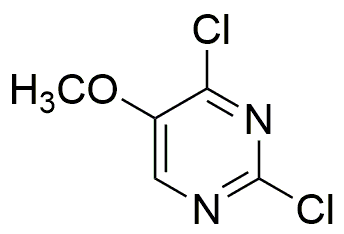2,4-Dichloro-5-methoxypyrimidine is widely utilized in research focused on:
- Pesticide Development: This compound is often used in the formulation of herbicides, providing effective weed control in agricultural settings while minimizing crop damage.
- Pharmaceutical Research: It serves as a key intermediate in the synthesis of various pharmaceuticals, particularly in the development of antiviral and anticancer agents.
- Biochemical Studies: Researchers employ this chemical in studies related to enzyme inhibition, helping to understand metabolic pathways and develop new therapeutic strategies.
- Material Science: Its properties make it suitable for creating specialized coatings and polymers, enhancing durability and resistance to environmental factors.
- Analytical Chemistry: The compound is used in analytical methods for detecting and quantifying other chemicals, aiding in quality control and regulatory compliance in various industries.
General Information
Properties
Safety and Regulations
Applications
2,4-Dichloro-5-methoxypyrimidine is widely utilized in research focused on:
- Pesticide Development: This compound is often used in the formulation of herbicides, providing effective weed control in agricultural settings while minimizing crop damage.
- Pharmaceutical Research: It serves as a key intermediate in the synthesis of various pharmaceuticals, particularly in the development of antiviral and anticancer agents.
- Biochemical Studies: Researchers employ this chemical in studies related to enzyme inhibition, helping to understand metabolic pathways and develop new therapeutic strategies.
- Material Science: Its properties make it suitable for creating specialized coatings and polymers, enhancing durability and resistance to environmental factors.
- Analytical Chemistry: The compound is used in analytical methods for detecting and quantifying other chemicals, aiding in quality control and regulatory compliance in various industries.
Documents
Safety Data Sheets (SDS)
The SDS provides comprehensive safety information on handling, storage, and disposal of the product.
Product Specification (PS)
The PS provides a comprehensive breakdown of the product’s properties, including chemical composition, physical state, purity, and storage requirements. It also details acceptable quality ranges and the product's intended applications.
Certificates of Analysis (COA)
Search for Certificates of Analysis (COA) by entering the products Lot Number. Lot and Batch Numbers can be found on a product’s label following the words ‘Lot’ or ‘Batch’.
*Catalog Number
*Lot Number
Certificates Of Origin (COO)
This COO confirms the country where the product was manufactured, and also details the materials and components used in it and whether it is derived from natural, synthetic, or other specific sources. This certificate may be required for customs, trade, and regulatory compliance.
*Catalog Number
*Lot Number
Safety Data Sheets (SDS)
The SDS provides comprehensive safety information on handling, storage, and disposal of the product.
DownloadProduct Specification (PS)
The PS provides a comprehensive breakdown of the product’s properties, including chemical composition, physical state, purity, and storage requirements. It also details acceptable quality ranges and the product's intended applications.
DownloadCertificates of Analysis (COA)
Search for Certificates of Analysis (COA) by entering the products Lot Number. Lot and Batch Numbers can be found on a product’s label following the words ‘Lot’ or ‘Batch’.
*Catalog Number
*Lot Number
Certificates Of Origin (COO)
This COO confirms the country where the product was manufactured, and also details the materials and components used in it and whether it is derived from natural, synthetic, or other specific sources. This certificate may be required for customs, trade, and regulatory compliance.


